What is a sports massage? It is a type of therapeutic massage designed to help athletes enhance their performance, reduce muscle tension, and aid in the healing process of injuries. Sports massage is usually performed before, during, and after physical activities to help prepare the body for maximum performance, reduce the risk of injury, and speed up the recovery process. This type of massage can help athletes of all levels achieve their goals by providing relief from tight muscles, improving flexibility, and increasing circulation. In addition to its physical benefits, sports massage has also been shown to improve mental focus and reduce stress.
Contents
What is Sports Massage Therapy?

Sports Massage Therapy is a type of massage designed to help athletes in their preparation for and recovery from athletic events. It is also used to help people with injuries, chronic pain, and restricted range of motion. It helps to improve flexibility and increase range of motion, as well as reduce stress, muscle tension and fatigue.
Sports massage therapy focuses on specific muscles and muscle groups that are used in sports activities. It is performed before and after exercise, as well as during the competition to help improve performance and reduce the risk of injury. It also helps to alleviate muscle pain and reduce swelling.
Sports massage therapy uses various techniques such as Swedish massage, myofascial release, trigger point therapy, and neuromuscular therapy to help athletes to achieve peak performance and reduce the risk of injury. These techniques help to increase blood flow, improve flexibility, reduce muscle tension and stress, and enhance the athlete’s overall performance.
Sports massage therapy can also be used to help athletes recover from injury and improve muscle recovery time. It helps to reduce swelling and inflammation, and increase circulation to the injured area. By improving circulation and decreasing muscle tension, it can help to reduce pain and speed up the healing process.
Sports massage therapy can also be used to help athletes to relax and reduce stress levels. The massage can improve mental focus and alertness, as well as helping to reduce stress and anxiety.
This type of massage therapy is beneficial for athletes of all levels, from beginners to professionals. It can help to improve performance, reduce the risk of injury, and help athletes to recover quickly.
What is a Sports Massage Therapist?
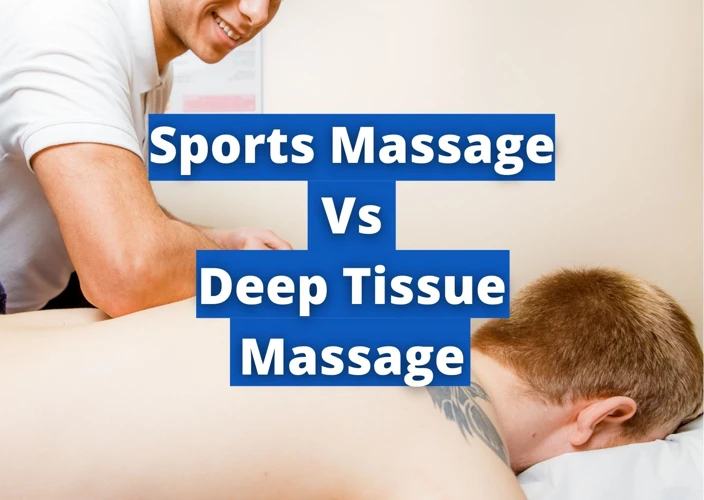
Sports massage therapists are health professionals who specialize in providing massage services to athletes and sports enthusiasts. They are extensively trained in the application of massage and bodywork techniques designed to improve sports performance and aid in the recovery from sports-related injuries.
- Sports massage therapists have a thorough understanding of anatomy and physiology, and use their knowledge to assess muscle imbalances and develop treatment plans.
- They use a variety of massage techniques including Swedish, deep tissue, trigger point, and structural integration to improve the body’s range of motion, reduce muscle tension, and improve overall performance.
- Sports massage therapists also provide injury prevention advice, tailored to the individual athlete’s sport and level of physical activity.
- Sports massage therapists are also adept at recognizing signs of overtraining, fatigue, stress, and dehydration that can lead to injury.
- They often work closely with other health professionals such as physical therapists, physicians, and athletic trainers to create comprehensive treatment plans for athletes.
Sports massage therapists are highly sought after for their ability to help athletes reach their peak performance. They use their knowledge and experience to provide athletes with the best possible massage services and to help them stay injury free.
What is the Definition of Sports Massage?
Sports massage is a form of manual therapy specifically designed to address the needs of athletes. It is a hands-on approach to bodywork that aims to help athletes improve physical performance, reduce muscle tension, and reduce the risk of injury.
Here are some interesting facts about sports massage:
- Sports massage is a type of therapeutic massage that combines specific techniques to help improve athletic performance and reduce the risk of injury.
- It is tailored to the individual athlete and their specific needs, such as enhancing range of motion, reducing muscle tension, and increasing circulation.
- Sports massage can also be used to help athletes recover from injury and enhance their overall performance.
- Sports massage is different from traditional massage in that it is targeted to specific muscle groups and is often performed before and after athletic events.
- Sports massage can be used to improve range of motion and flexibility, reduce recovery time, and reduce the risk of injury.
- It can also be used to address muscular imbalances, improve postural alignment, and restore balance to the body.
- Sports massage is an effective way to improve athletic performance, reduce fatigue, and promote overall wellness.
Sports massage can be used to help athletes achieve their peak performance, reduce pain, and maintain a healthy body. With the right techniques, sports massage can help athletes increase their range of motion, reduce muscle tension, and reduce the risk of injury.
How Does Sports Massage Work?
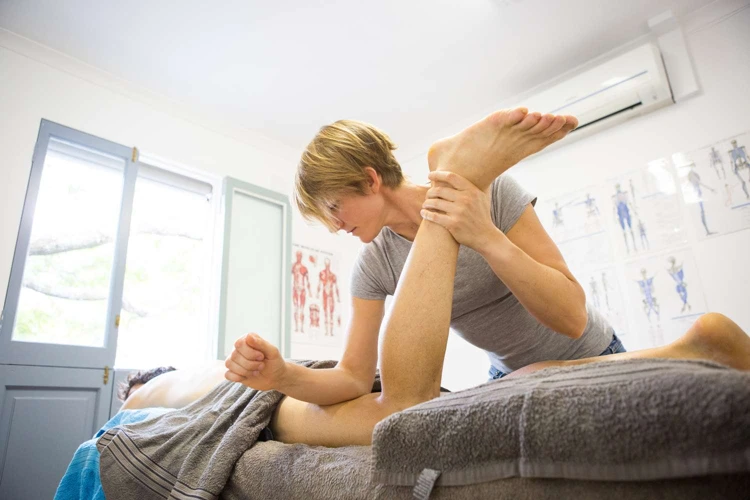
Sports massage is a form of bodywork that uses targeted deep tissue manipulation and muscle stretching to address specific areas of the body that have been overworked or injured. It is designed to help prevent and treat sports-related injuries, and to promote overall wellness.
Deep Tissue Massage
Deep tissue massage is a type of massage used to release chronic muscle tension and knots. It involves applying deep pressure to the soft tissues of the body to reach the deeper muscle layers. This type of massage can be used to treat sore muscles, reduce inflammation, and improve circulation.
Trigger Point Therapy
Trigger point therapy is a form of massage used to release knots and tight bands of muscle tissue. It involves applying pressure to “trigger points” in the body, which are areas of hyper-irritability that can cause pain and discomfort. By releasing these trigger points, the massage therapist can reduce pain and tension, and improve range of motion.
Myofascial Release
Myofascial release is a type of massage therapy used to release tightness and restrictions in the connective tissue (fascia). It involves applying gentle, sustained pressure to the fascia to encourage it to release, allowing the muscles to move more freely.
Muscle Stretching
Muscle stretching is a form of massage used to lengthen and stretch the muscles, improving flexibility and range of motion. It involves applying gentle pressure to the muscle while it is being stretched to release tightness and tension.
By combining these techniques, sports massage therapists are able to provide an effective, individualized treatment plan to help athletes of all levels improve their performance and prevent injuries. Sports massage is an increasingly popular form of therapy for athletes, and it can offer many benefits, including improved recovery time, improved flexibility and range of motion, and decreased pain and discomfort.
Benefits of Sports Massage
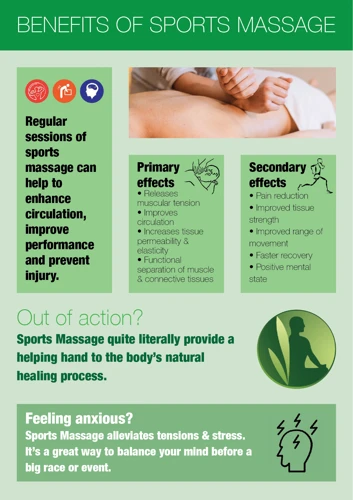
Sports Massage therapy is a form of massage which is tailored to the needs of athletes, to help them stay in peak physical condition. It is beneficial for athletes of all levels, from beginners to professional athletes. It helps athletes to improve their performance, reduce their risk of injury and speed up their recovery time. Sports Massage can also help to reduce muscle tension, improve range of motion and flexibility, and also improve circulation and posture.
Improved Performance: Regular sports massage can help athletes to improve their performance by helping to reduce fatigue and increase their endurance. It can also help to reduce the amount of time it takes for the muscles to recover after intense physical activity.
Reduced Risk of Injury: Sports massage can help athletes to reduce their risk of injury by helping to increase their range of motion and flexibility, as well as improving their posture. This can help to reduce the risk of injury caused by overuse or overstretching.
Faster Recovery Time: Sports massage can help athletes to recover more quickly after physical activity, as it helps to reduce muscle tension and increase circulation. This can help to reduce the amount of time it takes for the muscles to recover after intense physical activity.
Reduced Muscle Tension: Sports massage can help to reduce muscle tension, which can help to improve range of motion and flexibility, as well as reduce pain and soreness.
Improved Circulation: Sports massage can help to improve circulation, which can help to reduce the amount of time it takes for oxygen and nutrients to reach the muscles. This can help to improve the athlete’s overall performance and reduce fatigue.
Sports massage is a great way to improve an athlete’s performance, reduce the risk of injury and speed up recovery time. It can help to reduce muscle tension, improve range of motion and flexibility, and also improve circulation and posture. Sports Massage can be beneficial for athletes of all levels, from beginners to professional athletes.
Types of Sports Massage
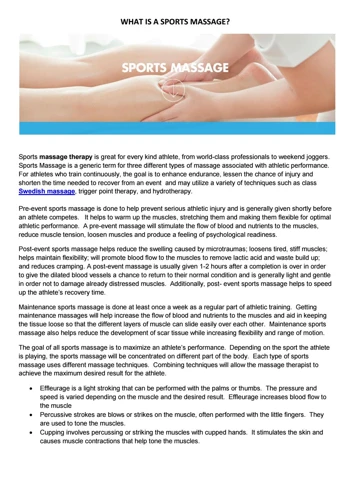
| Type | Description |
|---|---|
| Swedish Massage | This is the most common type of massage. It uses light to medium pressure to promote relaxation and relieve muscle tension. |
| Deep Tissue Massage | This is a more intense massage that focuses on releasing deeper layers of muscle and connective tissue. |
| Trigger Point Massage | This type of massage targets trigger points, which are tight knots of muscle that can cause pain in other parts of the body. |
| Sports Massage | This type of massage is specifically designed to help athletes prepare for and recover from sporting events. |
| Rehabilitative Massage | This type of massage is used to help treat injuries and is focused on restoring range of motion, strength, and flexibility. |
Sports massage is a type of massage that is specifically designed to help athletes prepare for and recover from sporting events. It combines techniques from Swedish massage, deep tissue massage, trigger point massage, and rehabilitative massage to target specific areas of the body. Sports massage can help to improve performance, reduce fatigue, and reduce the risk of injury.
Safety Considerations
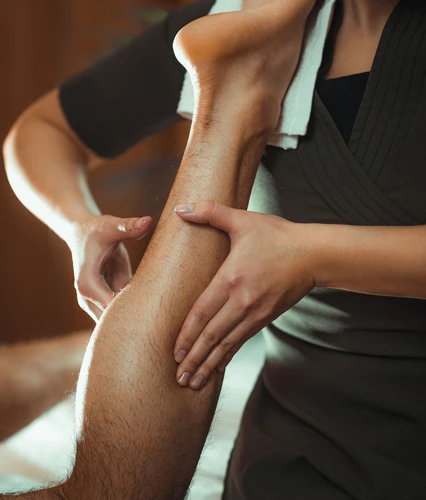
Sports massage therapy is a safe and effective technique to use, but it is important to take certain precautions. Consult with a doctor before undergoing a sports massage if you have an injury, illness, or medical condition. It is also important to inform the therapist of any medications you are taking and any allergies you might have.
When receiving a massage, it is important to communicate with the therapist about any areas of discomfort. Be sure to communicate about the amount of pressure being applied. If you experience any pain or discomfort during the massage, inform the therapist immediately.
It is important to drink plenty of water after a sports massage to help flush out toxins released from the muscles. Additionally, it is important to get enough rest after a massage to allow the body to heal and repair.
When choosing a massage therapist, it is important to make sure they are a licensed professional and have the appropriate qualifications and experience to safely perform sports massage techniques. It is also important to make sure the massage therapist is adequately insured.
Training and Certification
Sports massage therapists must complete extensive training and obtain certification to practice. A basic course of study may include anatomy, kinesiology, physiology, pathology, nutrition, and business management. Additionally, some massage therapists may pursue specialty certifications in sports massage. The American Massage Therapy Association (AMTA) offers a Sports Massage Certification program, which consists of both written and practical exams. The program focuses on the specific techniques and applications of sports massage, as well as the knowledge of how sports massage can help athletes. Upon successful completion of the program, practitioners receive the Sports Massage Therapist (SMT) credential.
Frequently Asked Questions
What are the Specific Techniques Used in Sports Massage?
Sports massage is a type of massage that focuses on the muscles and soft tissue associated with athletic activities. It is designed to prepare athletes for their best performance, reduce the risk of injury, and speed up post-workout recovery. Techniques used in sports massage include deep tissue massage, trigger point massage, and stretching. Deep tissue massage is used to target deeper layers of muscle and connective tissue, while trigger point massage is used to alleviate tightness and pain in specific areas. Stretching is a vital part of sports massage as it helps to increase flexibility and range of motion in the joints and muscles.
Is Sports Massage Suitable for Athletes of All Levels?
Yes, sports massage is suitable for athletes of all levels, from professional athletes to casual gym-goers. It helps to improve performance, reduce the risk of injury, and speed up recovery time. Here are some of the benefits:
- Decreases muscle tension and improves flexibility
- Promotes improved circulation
- Improves posture and range of motion
- Reduces the risk of sports-related injuries
- Speeds up recovery time after an injury or intense workout
- Increases energy levels and endurance
- Reduces stress and anxiety
Sports massage is a great way to help athletes of all levels reach their peak performance and maintain good health. Regular sports massage sessions can help keep muscles in peak condition and reduce the risk of injury.
What are the Risks associated with Sports Massage?
- Injury Risk: There is an inherent risk of injury when performing a sports massage, especially if the massage is too deep or too aggressive. This can cause bruising or muscle strain, which can lead to further complications.
- Allergic Reaction Risk: There is a risk of an allergic reaction to the massage oils or creams used during the massage.
- Embarrassment Risk: The client may feel embarrassed or uncomfortable if the massage is too intimate or if the therapist is not appropriately trained.
- Infection Risk: There is a risk of infection if the massage is not done properly and the therapist does not use proper sanitation techniques.
- Muscle Damage Risk: There is a risk of muscle damage if the massage is too deep or too aggressive, especially in areas that are already injured or weakened.
How long does a sports massage typically last?
- 30 Minutes: A 30-minute sports massage is usually focused on one particular area of the body and can be used to target a specific injury or area of tightness.
- 45 Minutes: A 45-minute sports massage is a great way to work on several areas of the body and is often used for athletes who need to work on multiple body parts in one session.
- 60 Minutes: A 60-minute sports massage is ideal for athletes who need to focus on several areas of tightness and injury prevention. This time frame allows for the massage therapist to spend more time on each area, which can be beneficial for athletes who need more intense attention.
Sports massage therapists will often tailor their massage sessions to the individual needs of their patients. Depending on the individual, the massage therapist may adjust the length of the massage session to ensure that the patient receives the best results.
Is Sports Massage Effective for Relieving Muscle Pain and Stiffness?
Sports massage therapy is a highly effective treatment for relieving muscle pain and stiffness. It uses a combination of deep-tissue massage, stretching, and joint mobilization to improve range of motion and reduce muscle tension. It can also help to reduce inflammation and improve circulation, increasing the body’s natural healing process. Studies have shown sports massage to be beneficial in reducing pain, improving range of motion, and decreasing muscle fatigue.
Conclusion
Sports massage is a powerful therapeutic tool that can help athletes of all levels to improve their performance, reduce the risk of injury, and maintain overall physical health. It can also help those who are not involved in sports by providing relief from pain and discomfort, improving flexibility and mobility, and aiding relaxation and stress relief. Whatever the reason for seeking a sports massage, it is important to choose a qualified and experienced practitioner who can tailor the treatment to meet the individual’s needs.

